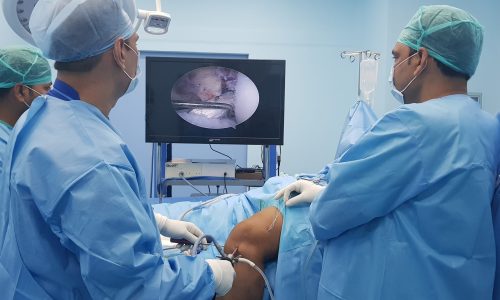
ACL Injury &
Reconstruction
ACL reconstruction is surgery to replace a torn anterior cruciate ligament (ACL) — a major ligament in your knee. ACL injuries most commonly occur during sports that involve sudden stops and changes in direction — such as cricket, basketball, football, wrestling and gymnastics.
In ACL reconstruction, the torn ligament is removed and replaced with a piece of tendon from another part of your knee or from a deceased donor. This surgery is an outpatient procedure that’s performed through small incisions around your knee joint. ACL reconstruction is performed by a doctor who specializes in surgical procedures of the bones and joints (orthopaedic surgeon).
ACL injury
Ligaments are strong bands of tissue that connect one bone to another. The ACL — one of two ligaments that crosses the middle of the knee — connects your thighbone (femur) to your shinbone (tibia) and helps stabilize your knee joint.
Most ACL injuries happen during sports and fitness activities that can put stress on the knee:
- Suddenly slowing down and changing direction (cutting)
- Pivoting with your foot firmly planted
- Landing from a jump incorrectly
- Stopping suddenly
- Receiving a direct blow to the knee
A course of physical therapy may successfully treat an ACL injury for individuals who are relatively inactive, engage in moderate exercise and recreational activities, or play sports that put less stress on the knees.
ACL reconstruction is generally recommended if:
- You’re an athlete and want to continue in your sport, especially if the sport involves jumping, cutting or pivoting
- More than one ligament or the meniscus in your knee is injured
- The injury is causing your knee to buckle during everyday activities
- You’re young (though other factors, such as activity level and knee instability, are more important than age)
How you prepare
Before your surgery, you’ll likely undergo several weeks of physical therapy. The goal before surgery is to reduce pain and swelling, restore your knee’s full range of motion, and strengthen muscles. People who go into surgery with a stiff, swollen knee may not regain full range of motion after surgery.
ACL reconstruction is an outpatient procedure, so you’ll be able to go home the same day. Arrange for someone to drive you home.
Food and medications
Tell your surgeon about any medications or dietary supplements you take. If you regularly take aspirin or other blood-thinning medications, your doctor may ask you to stop taking these types of drugs for at least a week before surgery to reduce your risk of bleeding.
Follow your doctor’s instructions about when to stop eating, drinking and taking any other medication the night before your surgery.
What you can expect
General or spinal anaesthesia is typically used during ACL reconstruction, so you’ll be comfortable during the procedure. ACL reconstruction is usually done through small incisions — one to hold a thin, tube-like video camera (arthroscope) and others to allow surgical instruments access to the joint space.
During the procedure
Your surgeon will remove your damaged ligament, and then replace it with a segment of tendon. This replacement tissue is called a graft and it comes from another part of your knee or a tendon from a deceased donor.
Your surgeon will drill sockets or tunnels into your thighbone and shinbone to accurately position the graft, which is then secured to your bones with screws or other fixation devices. The graft will serve as scaffolding on which new ligament tissue can grow.
After the procedure
Once you recover from the anesthesia, you can go home later that same day. Before you go home, you’ll practice walking with crutches, and your surgeon may ask you to wear a knee brace or splint to help protect the graft.
Your doctor will give you specific instructions on how to control swelling and pain after surgery. In general, it’s important to keep your leg elevated, apply ice to your knee and rest as much as possible.
Medications to help with pain relief include over-the-counter drugs such as acetaminophen (paracetamol), ibuprofen (brufen) and naproxen sodium (Naprosyn ). Your doctor might prescribe stronger medications, such as meloxicam (Mobic, Vivlodex, others) and gabapentin (Neurontin). If opioids are prescribed, they should be taken only for breakthrough pain as they have many side effects and a significant risk of addiction.
Follow your surgeon’s advice on when to ice your knee, how long to use crutches and when it’s safe to bear weight on your knee. You’ll also be instructed when you can shower or bathe, when you should change dressings on the wound, and how to manage post-surgery care.
Progressive physical therapy after ACL surgery helps to strengthen the muscles around your knee and improve flexibility. A physical therapist will teach you how to do exercises that you will perform either with continued supervision or at home. Following the rehabilitation plan is important for proper healing and achieving the best possible outcomes.
Results
Successful ACL reconstruction paired with focused rehabilitation can usually restore stability and function to your knee. Within the first few weeks after surgery, you should strive to regain a range of motion equal to that of your opposite knee. Recovery generally takes about nine months.
It may take six to 12 months or more before athletes can return to their sports.
ACL Repair Pic
